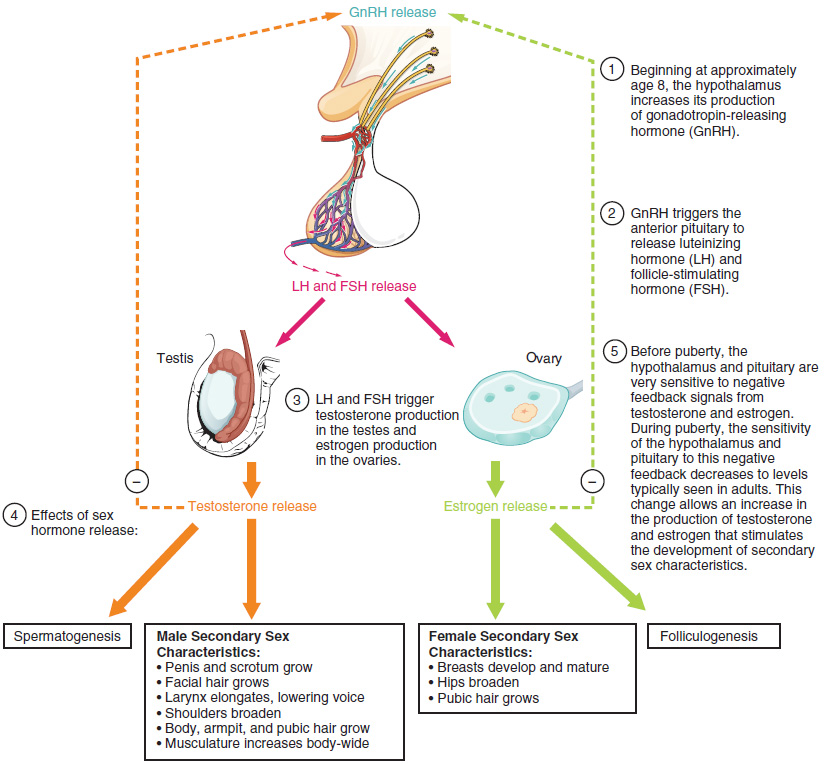Stages of Life
Puberty
Puberty is the stage of development at which individuals become sexually mature. Though the outcomes of puberty for males and females are very different, the hormonal control of the process is very similar. In addition, though the timing of these events varies between individuals, the sequence of changes that occur is predictable for male and female adolescents. Figure 1 shows a concerted release of hormones from the hypothalamus (GnRH), the anterior pituitary (LH and FSH), and the gonads (either testosterone or estrogen) is responsible for the maturation of the reproductive systems and the development of secondary sex characteristics, which are physical changes that serve auxiliary roles in reproduction.

The first changes begin around the age of eight or nine when the production of LH becomes detectable. The release of LH occurs primarily at night during sleep and precedes the physical changes of puberty by several years. In pre-pubertal children, the sensitivity of the negative feedback system in the hypothalamus and pituitary is very high. In other words, very low concentrations of androgens or estrogens will cause negative feedback onto the hypothalamus and pituitary, keeping the production of GnRH, LH, and FSH low.
As an individual approaches puberty, two changes in sensitivity occur. The first is a decrease of sensitivity in the hypothalamus and pituitary to negative feedback, meaning that it takes increasingly larger concentrations of sex steroid hormones to stop the production of LH and FSH. The second change in sensitivity is an increase in sensitivity of the gonads to the FSH and LH signals, meaning the gonads of adults are more responsive to gonadotropins than the gonads of children. As a result of these two changes, the levels of LH and FSH slowly increase and lead to the enlargement and maturation of the gonads, which in turn leads to the secretion of higher levels of sex hormones and the initiation of spermatogenesis and folliculogenesis.
In addition to age, multiple factors can affect the age of onset of puberty, including genetics, environment, and psychological stress. One of the more important influences may be nutrition; historical data demonstrate the effect of better and more consistent nutrition on the age of menarche in girls in the United States, which decreased from an average age of approximately 17 years of age in 1860 to the current age of approximately 12.75 years in 1960, as it remains today. Some studies indicate a link between puberty onset and the amount of stored fat in an individual. This effect is more pronounced in females but has been documented in both sexes. Body fat, corresponding with the secretion of the hormone leptin by adipose cells, appears to have a strong role in determining when menarche occurs. This may reflect, to some extent, the high metabolic costs of gestation and lactation. In individuals who are lean and highly active, such as gymnasts, there is often a delay in the onset of puberty.
Signs of Puberty
Different sex steroid hormone concentrations between the sexes also contribute to the development and function of secondary sexual characteristics.
Female Puberty
As a female reaches puberty, typically the first change that is visible is the development of the breast tissue due to the unopposed low dose estrogen stimulation for about two years before the first menses. This is followed by the growth of axillary and pubic hair. A growth spurt normally starts at approximately age 9 to 11, and may last two years or more. During this time, there is weight gain and an increase in body fat distribution, especially in the hips and thighs. Height can increase 3 inches a year.
Changes in the reproductive organs happen as the vagina lengthens and the labia majora and minora become thickened and rugated. These are followed by the start of menstruation and the first bleeding, menarche . Usually, menarche occurs two years after breast bud development due to fluctuating estrogen levels associated with follicle development. The age of menarche has currently declined to 12.2 years in the United States. Ovulation usually occurs within six months from the first episode of vaginal bleeding.
Male Puberty
In males, the growth of the testes is typically the first physical sign of the beginning of puberty and begins at a mean age of 11.6. This is followed by growth and pigmentation of the scrotum and growth of the penis. The adult size and shape of the penis and scrotum is achieved between ages 12 and 17 with an average of about 15 years of age. Next, increased hair growth occurs, including in the armpit, pubic, chest, and facial hair. Pubic hair development is complete at 15 years of age. Testosterone stimulates the growth of the larynx and thickening and lengthening of the vocal folds, which causes the voice to drop in pitch, at an average age of 13.
Spontaneous erection and nocturnal emission may occur, which decrease gradually. The first fertile ejaculations typically appear at approximately 15 years of age, but this age can vary widely across individuals. Unlike the early growth spurt observed in females, the male growth spurt occurs toward the end of puberty, at approximately age 11 to 13. The growth spurt continues over time, with 45% of the adult skeletal mass acquired between age 11 and age 18. A youth’s height can increase as much as 4 inches a year. In some males, development can continue through the early 20s.
| Male | Female |
| Increased larynx size and deepening of the voice | Deposition of fat, predominantly in breasts and hips |
| Increased muscular development | Breast development |
| Growth of facial, axillary, and pubic hair, and increased growth of body hair | Broadening of the pelvis and growth of axillary and pubic hair |

